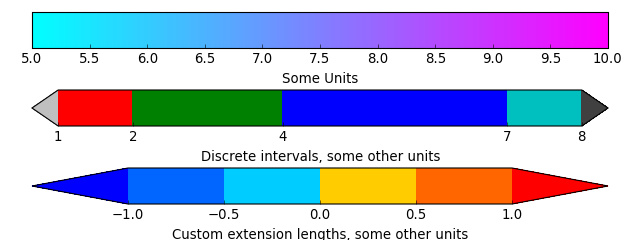

(Source code, png)

'''
Make a colorbar as a separate figure.
'''
from matplotlib import pyplot
import matplotlib as mpl
# Make a figure and axes with dimensions as desired.
fig = pyplot.figure(figsize=(8, 3))
ax1 = fig.add_axes([0.05, 0.80, 0.9, 0.15])
ax2 = fig.add_axes([0.05, 0.475, 0.9, 0.15])
ax3 = fig.add_axes([0.05, 0.15, 0.9, 0.15])
# Set the colormap and norm to correspond to the data for which
# the colorbar will be used.
cmap = mpl.cm.cool
norm = mpl.colors.Normalize(vmin=5, vmax=10)
# ColorbarBase derives from ScalarMappable and puts a colorbar
# in a specified axes, so it has everything needed for a
# standalone colorbar. There are many more kwargs, but the
# following gives a basic continuous colorbar with ticks
# and labels.
cb1 = mpl.colorbar.ColorbarBase(ax1, cmap=cmap,
norm=norm,
orientation='horizontal')
cb1.set_label('Some Units')
# The second example illustrates the use of a ListedColormap, a
# BoundaryNorm, and extended ends to show the "over" and "under"
# value colors.
cmap = mpl.colors.ListedColormap(['r', 'g', 'b', 'c'])
cmap.set_over('0.25')
cmap.set_under('0.75')
# If a ListedColormap is used, the length of the bounds array must be
# one greater than the length of the color list. The bounds must be
# monotonically increasing.
bounds = [1, 2, 4, 7, 8]
norm = mpl.colors.BoundaryNorm(bounds, cmap.N)
cb2 = mpl.colorbar.ColorbarBase(ax2, cmap=cmap,
norm=norm,
# to use 'extend', you must
# specify two extra boundaries:
boundaries=[0] + bounds + [13],
extend='both',
ticks=bounds, # optional
spacing='proportional',
orientation='horizontal')
cb2.set_label('Discrete intervals, some other units')
# The third example illustrates the use of custom length colorbar
# extensions, used on a colorbar with discrete intervals.
cmap = mpl.colors.ListedColormap([[0., .4, 1.], [0., .8, 1.],
[1., .8, 0.], [1., .4, 0.]])
cmap.set_over((1., 0., 0.))
cmap.set_under((0., 0., 1.))
bounds = [-1., -.5, 0., .5, 1.]
norm = mpl.colors.BoundaryNorm(bounds, cmap.N)
cb3 = mpl.colorbar.ColorbarBase(ax3, cmap=cmap,
norm=norm,
boundaries=[-10] + bounds + [10],
extend='both',
# Make the length of each extension
# the same as the length of the
# interior colors:
extendfrac='auto',
ticks=bounds,
spacing='uniform',
orientation='horizontal')
cb3.set_label('Custom extension lengths, some other units')
pyplot.show()
Keywords: python, matplotlib, pylab, example, codex (see Search examples)